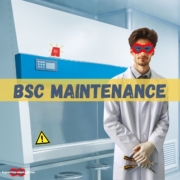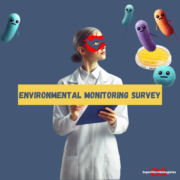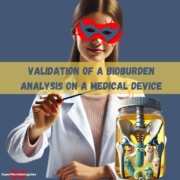New ISO 7218:2024 Standard: What’s Different?
We’ve been waiting for months! Here is (finally) the new ISO 7218:2024 standard that replaces ISO 7218:2007 (and its 2013 amendment).
But what changes will this new version bring to our accredited microbiology laboratories?
To find out, we asked Nadège Pioche and Muriel Coignard to explain the differences between the old and new versions.
Best QC strains
Food & Water : The best QC Strain suppliers
We polled the SuperMicrobiologists.
Here are their favorite QC Strains
1 – Precautions Against Cross-Contamination
The previous standard covered cross-contamination, but the new 2024 version provides more detailed guidelines and stricter requirements to ensure laboratories follow best practices to minimize this risk.
Sample Separation:
ISO 7218:2024 strongly encourages separating sample preparation flows based on their nature and potential contamination (Section 4.4.2).
This separation can be done in time (one after the other) or space (dedicating rooms and equipment for each type of product) (Section 4.5.1).
Examples:
- Separate the analysis of powdered products from those known to have high contamination (Section 4.4.2).
- Separate the analysis of “sterile” food products from other samples (Section 4.4.2).
- Allocate dedicated equipment for pathogen analyses (pipettes, carts) (Section 6.1).
Personnel Hygiene:
To limit cross-contamination in the lab, new precautions regarding personnel hygiene have been added.
Examples:
- Use long-sleeved lab coats with “elastic cuffs” (Section 5.4).
- Use shoes dedicated to handling pathogens (Section 5.4).
- Leave phones, earbuds, and jewelry outside the lab (Section 5.4).
Nadège Pioche’s opinion:
New requirements regarding the separation of samples based on their criticality will impact small labs and may require reorganization. The dress code formalizes already adopted good practices in many labs.
Muriel Coignard’s opinion :
Most company labs have established rules regarding jewelry and personal items, unlike service labs which will need to adapt. Banning personal items and jewelry will make hand washing easier and reduce cross-contamination risks (e.g., via phones).
2 – Internal Quality Control (IQC)
The new ISO 7218 version offers a much more detailed description of IQC.
Process Controls Definition
Different process controls are clearly listed and described (blanks, positive controls, negative controls, etc.) (Section 16.2.2).
QC Strain Selection
A new section provides information on selecting strains based on the nature of the analyses (Section 14).
Section 16.2.2.3 details the strains used as positive controls, which should be “similar to contaminant strains” but “easily distinguishable” in case of cross-contamination.
It even recommends using rare or genetically modified microorganisms (fluorescent or luminescent).
Contamination Levels
For qualitative tests, it is advised to use positive controls with very low contamination levels, between 3 and 10 cfu (Section 16.2.2.3).
Control Plan
The IQC program should be proportional to the number of samples analyzed (Section 16.2.1).
It means that laboratories should decide the acceptable risk level for non-conformity based on a risk analysis, which typically translates into the number of tests to be repeated.
Nadège Pioche’s opinion:
The cost for labs will increase due to purchasing strains and “free” analyses. Labs must balance quality control and cost. No specific frequency is recommended; labs will design their quality program based on risk assessment. Integrating these controls risks cross-contamination. Labs should organize these controls close to routine samples for representative results while securing the process and environment.
Muriel Coignard’s opinion :
The new version’s quality control plan elements are well elaborated. Labs will need to develop a control program suited to their activities, balancing doing “enough” without overdoing it.
Although controls with target strains risk cross-contamination, using rare or easy-to-identify strains should minimize this risk. Low contamination levels for positive controls will make tests more relevant.
3 – Sample Transport Temperatures and Sample Freezing
Sample Transport Temperatures
Transport temperatures for stable and unstable samples are modified (Section 9.2):
- Stable Products: Should be transported at ambient temperature between 18°C and 27°C, instead of <40°C.
- Unstable Products at Ambient Temperature: Should be transported at 5°C ± 3°C, instead of 1 to 8°C.
Nadège Pioche’s opinion:
Laboratories will need to implement logistical tools to transport stable products between 18°C and 27°C. Furthermore, unstable and stable products can no longer be transported together. This change might impact transport costs.
Sample Freezing
Freezing samples before and after testing is prohibited to avoid altering microbial load (Section 9.3).
Nadège Pioche’s opinion:
First of all, I think it is a relevant modification when one understands the impact that freezing can have on a microbial population.
Not being able to freeze non-stable samples at ambient temperature and needing to analyze them within 24-36 hours post-collection will affect lab organization, especially on weekends.
Labs must either run analyses on weekends (requiring staff) or delay analyses (resulting in non-accredited results).
This also impacts transport, as stable products can no longer be sent under the same conditions as refrigerated products.
Should all samples be transported at regulated temperatures? This may incur additional costs for labs.
Muriel Coignard’s opinion :
Freezing has a detrimental effect on microorganisms, particularly Gram-negative bacteria. Therefore, it is important that this new version prohibits freezing before analysis (except for already frozen products).
The standard also prohibits re-testing an already analyzed sample solely to obtain a “better” result: this prohibition aligns with Codex recommendations for many years.
Some laboratories, accustomed to freezing their clients’ samples to facilitate lab organization, will need to learn to work differently: starting analyses upon receipt, working on Saturdays and Sundays, or using refrigerated incubators.
With the GEN REF 11 from COFRAC requiring that all results be reported under accreditation once the parameter is within the lab’s accreditation scope, most labs have already adapted and stopped freezing since 2021.
4 – Dilution and Stock Suspension
Successive Dilutions
Using volumes of 1 ml and 0.1 ml of the stock suspension is considered as “successive dilutions” (Section 11.2.1).
SuperMicrobiologistes’s opinion :
This allows saving one dilution tube and… manipulation time. Not bad, isn’t it ?!
Inoculum Volume >1ml
When expecting low numbers of microorganisms (< 10 cfu/ml), the volume of inoculum used for deep seeding can be increased (e.g., more than 1 ml).
However, it is important to maintain the same ratio between the volume of inoculum and the amount of culture medium as for a 1 ml inoculum (Section 11.2.2).
Muriel COIGNARD’s opinion :
These new methods will allow for i) the use of fewer dilution tubes and ii) the inoculation of larger volumes in large Petri dishes (140 mm diameter), thereby reducing the number of inoculated dishes when laboratories need to reach a detection threshold of < 1 cfu / g.
Inoculation of the mother suspension
In the previous version, there was up to 45 minutes between the preparation of the mother suspension and the inoculation. Now, there are 20 minutes with a maximum of 45 minutes (Section 10.2.1).
Muriel COIGNARD’s opinion :
The COFRAC evaluators are likely to be stricter about the maximum time between the completion of the mother suspension preparation and the pouring of the agar into Petri dishes, since the standard now indicates a shorter recommended time. Laboratories may reduce the number of samples per series to ensure they do not exceed the 45-minute limit.
5 – Calculations: Removal of N’
N’ was used when the calculation of a weighted average was not possible because only one plate was countable. N’ is no longer mentioned.
Muriel COIGNARD’s opinion :
This will simplify the LIMS configuration for newly accredited laboratories.
6 – Metrology: Temperature profile for the incubation of large test samples
The sampling of test samples larger than 25g (e.g., 375g) is now mentioned (Section 12.1).
Given that these larger volume enrichment broths take longer to heat up, it is necessary to ensure that this heating time is taken into account to meet the specified incubation durations in the standard. A temperature profile should be conducted (Section 6.3.2.4).
Muriel COIGNARD’s opinion :
Laboratories analyzing large sample weights were already accustomed to verifying these profiles. However, they will now need to keep proof of these verifications.
7 – Fewer controls for RTU culture media
Performance testing of culture media can be reduced when using Ready-to-Use (RTU) media, according to ISO 11133.
However, it will be necessary to verify that the transportation and storage conditions have been properly maintained (Section 8).
SuperMicrobiologistes’s opinion:
Ask your supplier of Ready-to-Use (RTU) culture media what measures they can implement to ensure that transportation conditions (temperature) are maintained.
Example: A data logger thermometer can be placed in the box, and some trucks are also equipped with temperature control systems.
This is commonly done for RTU culture media used in the pharmaceutical industry.
8 – Test Report: Addition of the Year of Publication
The year of publication of the international standard used should now be mentioned in the report (Section 15).
Muriel COIGNARD’s opinion :
Conversely, this requirement, which in my opinion contradicts the concept of the FLEX1 flexible scope of COFRAC, will force laboratories to review the settings of all parameters in their LIMS to include the year of the standard. In case of modifications, the settings will need to be revised.
9 – Confirmations and Identifications: New Methods
Section 13.1 allows for the use of new confirmation and identification methods, such as mass spectrometry or sequencing.
Unless otherwise specified, these methods can be used in place of the serological and biochemical tests specified in the standards.
10 – Study of Deviations
Several times in this new version of ISO 7218:2024, it is mentioned that all non-compliant results should be recorded and corrective actions should also be implemented.
Examples:
- It is necessary to study any deviation from expected results or any unsatisfactory result and to provide additional training to the personnel.” (Section 5.3)
- When evaluating EA results, it is important not only to examine individual scores but also to look for potential trends in order to assess and, if necessary, correct any potential bias.” (Section 16.3)
- It is necessary to examine tests identified as not being controlled (cause analysis) and then, if necessary, implement appropriate corrective actions.” (Section 16.2.1)
Bonus: What does the ISO 7218:2024 standard change for spiral plating methods?
We asked this question to Manon Laborie, Application Support Manager at Interscience and member of the group that worked, alongside her colleague Sylvie Viboud, on this new standard.
The new version of ISO 7218 incorporates updates regarding the Spiral technique and potentially opens its use for the enumeration of other quality indicators such as Lactic Flora, Staphylococcus aureus, and others.
Indeed, the Spiral technique is now considered an inoculation technique equivalent to surface plating. Previously often regarded as a “method,” it required validation, whereas an inoculation “technique” requires verification of its applicability in the laboratory if proposed by the standard (Sections 6.4.3, 11.2.3.3, and 11.2.6.2).
This new version of ISO 7218 supports users of the Spiral technique with interpretation rules by detailing general and specific cases to provide results that closely meet the laboratory’s criteria (Section 11.2.6.2).
The paragraph on the Spiral technique details and facilitates the implementation of this inoculation technique in the laboratory. It also guides users in choosing the diluent, such as the use of saline solution, NaCl at 0.9%.
Recommendations are also provided for the disinfectant used, which can be 70% ethanol or bleach with an active chlorine percentage according to the manufacturer’s recommendations (Section 6.4.3.2).
Additionally, the changes in this standard include the ability to automatically dilute the sample before inoculation, all on the same automated system (Section 6.4.4).
There you go, you are now more or less up to date with the new version of the ISO 7218 standard.
If you work in a microbiology laboratory in the food chain, we still recommend taking the time to read the standard carefully.
And if you have noticed other important changes, feel free to share them in the comments!
We would like to extend our heartfelt thanks to Nadège Pioche and Muriel Coignard for the considerable time they dedicated to explaining this standard and its modifications to us.













Thank you for this accurate and clear analysis of the main changes between the 2 versions of ISO 7218 prepared under the responsabilty of ISO TC 34 SC 9 that I chair.